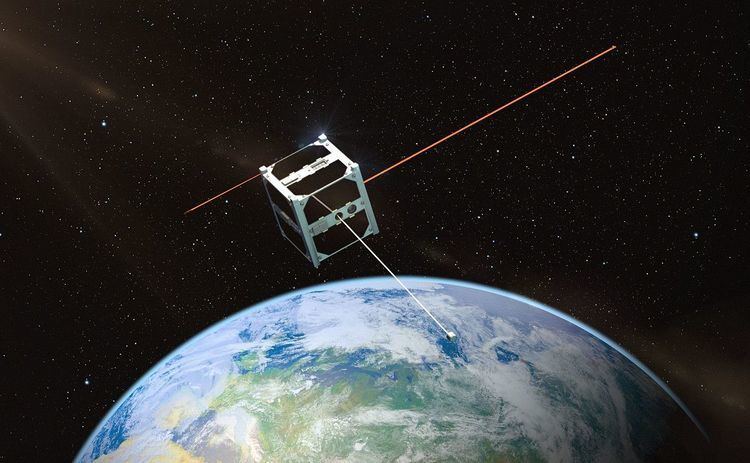 | ||
An electric sail (also called electric solar wind sail or E-sail) is a proposed form of spacecraft propulsion using the dynamic pressure of the solar wind as a source of thrust. It creates a "virtual" sail by using small wires to form an electric field that deflects solar wind protons and extracts their momentum. It was invented by Pekka Janhunen in 2006 at the Finnish Meteorological Institute.
Contents
Development history
To test the technology, a new European Union-backed electric sail study project was announced by the FMI in December 2010. The EU funding contribution was 1.7 million euros. Its goal was to build laboratory prototypes of the key components, it involved five European countries and ended in November 2013. In the EU evaluation, the project got the highest marks in its category. The technology could enable faster and cheaper access to the Solar System, and in the longer run may enable an economic utilisation of asteroid mining. An attempt was made to test the working principles of the electric sail in low Earth orbit by Estonian nanosatellite ESTCube-1 (2013-2015), but the piezoelectric motor failed to turn the reel. In subsequent ground-based testing, a likely reason for the failure was found in a slipring contact which was likely physically damaged by launch vibration. With the expected launch time of May 2016, the Finnish Aalto-1 nanosatellite will test the electric sail.
An international research team that includes Janhunen received funding through a 2015 NIAC Phase II solicitation for further development at NASA's Marshall Space Flight Center. Their research project is called 'Heliopause Electrostatic Rapid Transit System' (HERTS).
Principles of operation and design
The electric sail consists of a number of thin, long and conducting tethers which are kept in a high positive potential by an onboard electron gun. The positively charged tethers deflect solar wind protons, thus extracting momentum from them. Simultaneously they attract electrons from the solar wind plasma, producing an electron current. The electron gun compensates for the arriving electric current.
One way to deploy the tethers is to rotate the spacecraft, using centrifugal force to keep them stretched. By fine-tuning the potentials of individual tethers and thus the solar wind force individually, the spacecraft's attitude can be controlled.
E-sail missions can be launched at almost any time with only minor variations in travel time. By contrast, conventional slingshot missions must wait for the planets to reach a particular alignment.
Intrinsic limitations
The electric sail probably cannot be used inside planetary magnetospheres because the solar wind does not penetrate them, allowing only slower plasma flows and magnetic fields. While modest variation of the thrust direction can be achieved by inclining the sail, the thrust vector always points more or less radially outward from the Sun. It has been estimated that maximum operational inclination would be 60°, resulting in a thrusting angle of 30° from the outward radial direction.
Electric solar wind sail
The electric solar wind sail has little in common with the traditional solar sail. The E-sail gets its momentum from the solar wind ions, whilst a photonic sail is propelled by photons. In the E-sail, the part of the sail is played by straightened conducting tethers (made of wires) which are placed radially around the host ship. The wires are electrically charged and thus an electric field is created around the wires. The electric field of the wires extends a few dozen metres into the surrounding solar wind plasma. The penetration distance depends on the solar wind plasma density and it scales as the plasma Debye length.
Because the solar wind electrons affect the electric field (similarly to the photons on a traditional solar sail), the effective electric radius of the tethers is based on the electric field that is generated around the tether rather than the actual tether itself. This fact also makes it possible to manoeuvre by regulating the tethers' electric charge. A full-sized sail would have 50–100 straightened tethers with a length of about 20 km each.
In order to minimise damage to the thin tethers from micrometeoroids, the tethers would be formed from multiple strands, 25–50 micrometers in diameter, welded together at regular intervals. Thus, even if one wire was severed, a conducting path along the full length of the braided wire would remain in place. The feasibility of using ultrasonic welding was demonstrated at the University of Helsinki in January 2013.
Applications
Uranus entry probe
Janhunen et al. have proposed a mission to Uranus powered by an electric sail. The mission could reach its destination in about the same time that the earlier Galileo space probe required to arrive at Jupiter, just over one fourth as far away. Galileo took 6 years to reach Jupiter at a cost of $1.6 billion, while Cassini-Huygens took 7 years to get to Saturn and cost almost as much. The sail is expected to consume 540 watts, producing about 0.5 newtons accelerating the craft by about 1 mm/s2. The craft would reach a velocity of about 20 km/s by the time it reaches Uranus, 6 years after launch.
The proposed craft has three parts: the E-sail module with solar panels and reels to hold the wires; the main body, including chemical thrusters for adjusting trajectory en route and at destination and communications equipment; and a research module to enter Uranus' atmosphere and make measurements for relay to Earth via the main body.
